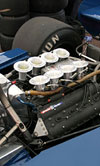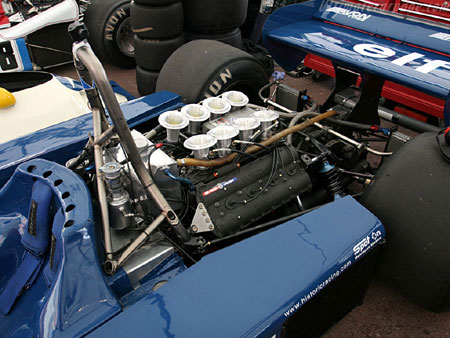Further Applications of Polymer Coatings in Racing Engines
 In a previous article on polymer coatings, I considered their application to pistons. Using polymer coatings on piston skirts remains popular for reducing friction and improving running-in behaviour. They have also been used for the rapid development of optimised piston skirt profiles, and this has been discussed in peer-reviewed technical literature.
In a previous article on polymer coatings, I considered their application to pistons. Using polymer coatings on piston skirts remains popular for reducing friction and improving running-in behaviour. They have also been used for the rapid development of optimised piston skirt profiles, and this has been discussed in peer-reviewed technical literature.
This month we shall look at some of the past and present applications of polymer coatings in racing engines besides piston skirts, although there isn't room here to cover all the applications.
Staying with pistons for the moment, however, polymers were used briefly by some manufacturers when DLC-coated gudgeon pins (piston pins/wrist pins) started to become popular. Some early coated pins tended to wear the pin bore in the soft aluminium piston. Whether coating technology or preparation was to blame at the time is not certain, but one successful solution was a surface treatment that involved a polymeric component. An electroless nickel/PTFE 'composite' coating was one company's way out of this problem. DLC-coated gudgeon pins nowadays run happily in many racing engines.
Polymer coatings were once seen as a cure-all by some engine builders, and you might still find polymer-coated connecting rods in some engines that have not been rebuilt for many years. The idea behind this is to promote oil shedding in the hope of lower friction, but the practice seems to have fallen out of use. In a similar vein, I have seen inside dry-sump racing engines originally put together in the 1970s to find the internal cavities of crankcases, especially the lower crankcase (sump), coated with the a green polymer compound.
An example of where we might find such 'hopeful' applications of polymer coatings by privateer builders is the widely used Ford/Cosworth DFV, as shown in the picture here.
Coating the outside of aluminium (and sometimes steel) cylinder liners with polymers has been popular for many years, and many companies continue to do this. The reasons are to prevent damage to the liner or cylinder block during fitting and to minimise the effects of fretting damage between the components, possibly by eliminating cold-welding between similar metals. In any case, even if the polymer coating's wear rate is relatively fast, replacing the coating is generally less expensive than replacing the cylinder liner.

In the case of a steel or cast-iron liner in a water-cooled engine, a polymer coating can prevent corrosion of the part. It can also prevent galvanic corrosion, where dissimilar metals are in contact in the presence of an electrolyte, becoming a problem.
Coating pump components - both rotating and static - with polymers has been common for many years.
Engine builders have also used polymer coatings as a tentative first step toward material substitution, to convince themselves that by swapping from a metal to a polymer component, the wear of the polymer won't be an immediate problem.
Fig. 1 - The Ford/Cosworth DFV has seen privateer builders using polymer coatings in the most unlikely places
Written by Wayne Ward